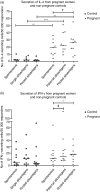CD4+ CD25+ regulatory T cells in human pregnancy: development of a Treg-MLC-ELISPOT suppression assay and indications of paternal specific Tregs
- PMID: 17229266
- PMCID: PMC2265909
- DOI: 10.1111/j.1365-2567.2006.02529.x
CD4+ CD25+ regulatory T cells in human pregnancy: development of a Treg-MLC-ELISPOT suppression assay and indications of paternal specific Tregs
Abstract
The current study was aimed at developing a one-way mixed leucocyte culture-enzyme-linked immunospot (MLC-ELISPOT) assay for the study of CD4(+) CD25(+) regulatory T (T(reg)) cells and applying this method in the study of antifetal immune reactions during human pregnancy. Twenty-one pregnant women and the corresponding fathers-to-be, and 10 non-pregnant control women and men, participated in the study. CD4(+) CD25(+) cells were isolated from peripheral blood mononuclear cells (PBMC) by immunomagnetic selection. Maternal/control PBMC were stimulated with paternal or unrelated PBMC in MLC. Secretion of interleukin-4 (IL-4) and interferon-gamma (IFN-gamma) from responder cells, with or without the presence of autologous T(reg) cells, was analysed by ELISPOT. PBMC from pregnant women showed increased secretion of IL-4 compared to controls. In pregnant and non-pregnant controls, T(reg) cells suppressed IFN-gamma reactivity against paternal and unrelated alloantigens. Interestingly, T(reg) cells suppressed IL-4 secretion against paternal but not unrelated alloantigens during pregnancy. We have successfully developed a model for studying T(reg) cells in antifetal cytokine reactions during pregnancy. Results indicate that T(reg) cells contribute to strict regulation of both T helper type 1-like and type 2-like antifetal immune reactions. Interestingly, T helper type 2-like cells specific to unrelated alloantigens are able to escape the suppression of T(reg) cells, which would allow for IL-4, alongside CD4(+) CD25(+) T(reg) cells, to control potentially detrimental IFN-gamma reactions during pregnancy.
Figures






References
-
- Sakaguchi S, Sakaguchi N, Asano M, Itoh M, Toda M. Immunologic self-tolerance maintained by activated T cells expressing IL-2 receptor alpha-chains (CD25). Breakdown of a single mechanism of self-tolerance causes various autoimmune diseases. J Immunol. 1995;155:1151–64. - PubMed
-
- Itoh M, Takahashi T, Sakaguchi N, Kuniyasu Y, Shimizu J, Otsuka F, Sakaguchi S. Thymus and autoimmunity. production of CD25+CD4+ naturally anergic and suppressive T cells as a key function of the thymus in maintaining immunologic self-tolerance. J Immunol. 1999;162:5317–26. - PubMed
-
- Coutinho A, Caramalho I, Seixas E, Demengeot J. Thymic commitment of regulatory T cells is a pathway of TCR-dependent selection that isolates repertoires undergoing positive or negative selection. Curr Top Microbiol Immunol. 2005;293:43–71. - PubMed
-
- Hauben E, Bacchetta R, Roncarolo MG. Utilizing regulatory T cells to control alloreactivity. Cytotherapy. 2005;7:158–65. - PubMed
Publication types
MeSH terms
Substances
LinkOut - more resources
Full Text Sources
Medical
Research Materials

